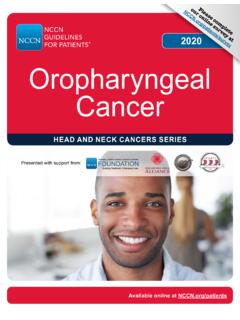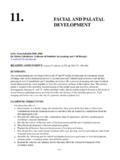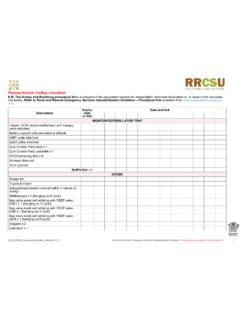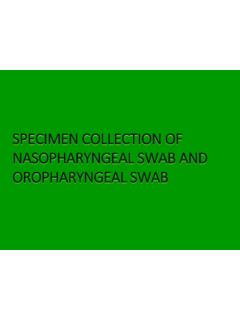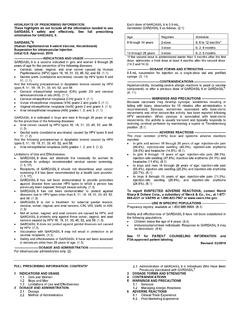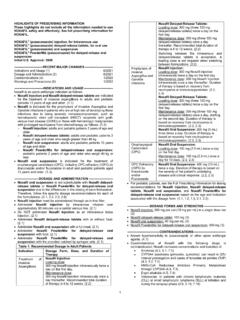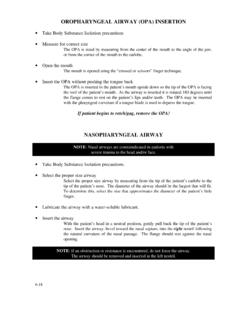Transcription of Yale Swallow Protocol - SA Swallowing Services, PLLC
1 Information Provided by SA Swallowing Services, PLLC., 2014 Yale Swallow Protocol Step 1: Exclusion Criteria ____ Yale Swallow Protocol Deferred due to NO concern for aspiration risk. Any YES answer to the following risk factors will also defer administration to Protocol : Yes No ____ ____ Unable to remain alert for testing. ____ ____ Eating a modified diet (thickened liquids) due to pre- existing dysphagia. ____ ____ Existing enteral tube feeding via stomach or nose. ____ ____ Head- of- bed restrictions <30 . ____ ____ Tracheostomy tube present.
2 ____ ____ Nil per os by physician order. If the patient s clinical status changes resulting in a new risk for aspiration, the Protocol must be readministered before oral alimentation or medications are ordered. Step 2: Administration Instructions If patient is deemed an aspiration risk and all exclusion criteria in Step 1 are checked NO, proceed with Protocol : Brief Cognitive Screen: What is your name? Where are you right now? What year is it? Oral- Mechanism Examination Labial closure Lingual range of motion Facial symmetry (smile/pucker) Perform 3- ounce water Swallow challenge: Sit patient upright at 80- 90 (or as high as tolerated >30 ).
3 Ask patient to drink the entire 3 ounces (90cc) of water from a cup or with a straw, in sequential swallows, and slow and steady but without stopping. (Note: Cup or straw can be held by clinician or patient.) Assess patient for interrupted drinking and coughing or choking during or immediately after completion of drinking. Note: Information from the brief cognitive screen and oral mechanism examination provide information on odds of aspiration risk with the 3- ounce water Swallow challenge and should not be used as exclusionary criteria for screening.
4 Information Provided by SA Swallowing Services, PLLC., 2014 Step 3: Pass/Fail Criteria Results and Recommendations _____ PASS: Complete and uninterrupted drinking of all 3 ounces of water without overt signs of aspiration, , coughing or choking, either during or immediately after completion. If patient passes, collaborate with MD/PA/LIP to order appropriate oral diet. If dentate, order a soft solid consistency or regular consistency diet. If edentulous, order a liquid and puree diet. _____ FAIL: Inability to drink the entire 3 ounces in sequential swallows due to stopping/starting or patient exhibits overt signs of aspiration, , coughing or choking, either during or immediately after completion.
5 If patient fails, keep nil per os (including medications) and discuss with the MD/PA/LIP the need for an objective Swallowing evaluation by speech- language pathologist. Readminister the Protocol in 24 h if patient shows clinical improvement. (Taken from: Suiter, , Sloggy, J., & Leder, (2014). Validation of the Yale Swallow Protocol : A prospective double- blinded videofluoroscopic study. Dysphagia, 29, 199- 203.) Validation Information 1. Three- ounce water Swallow test validation first reported on 44 stroke patients by DePippo et al. (1992). Failure required referral for objective (VFSS) dysphagia test.
6 2. A revised 3- ounce water Swallow challenge administered to 3,000 hospitalized patients with 14 distinct diagnoses and referenced with FEES as the standard correctly predicted aspiration of the time, with a negative predictive value of , and a false negative rate of (Suiter, & Leder, [2008]. Clinical utility of the 3- ounce water Swallow test. Dysphagia, 23, 244- 250.) 3. Validation study of Yale Swallow Protocol was reported using 25 subjects with categorical diagnoses of esophageal surgery, head & neck cancer, neurosurgery, medical issues, or neurological (CAV, MS, TBI) and using VFSS as the standard reference.
7 Seven participants passed and 18 failed the 3- ounce Swallow challenge. Of the 18 who failed, 14 aspirated on VFSS (true positives) and 4 did not aspirate on VFSS (false positives). Sensitivity for the Protocol = 100%, specificity = 64%, positive predictive value = 78%, and negative predictive value = 100%. All participants who passed the Protocol , , deemed to have no aspiration risk, also did not aspirate during VFSS. (Suiter, , Sloggy, J., & Leder, [2014). Validation of the Yale Swallow Protocol : A prospective double- blinded videofluoroscopic study.]
8 Dysphagia, 29, 199- 203.)
